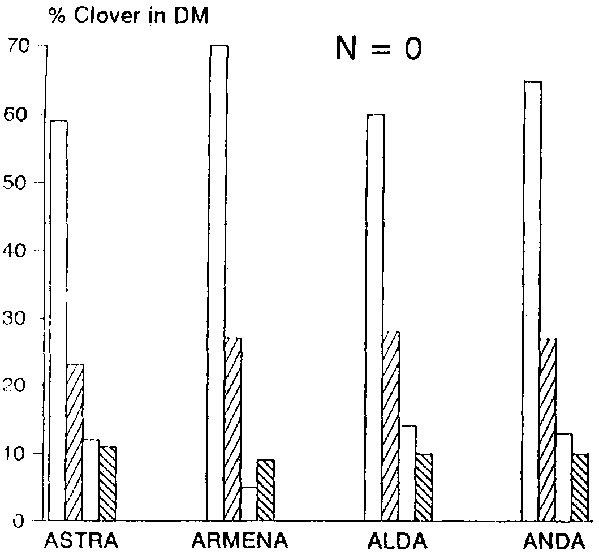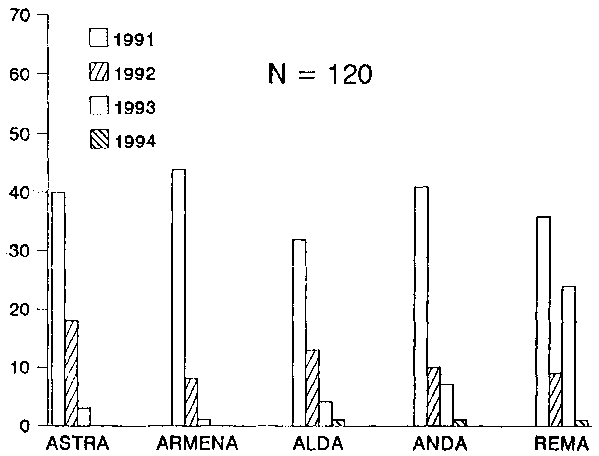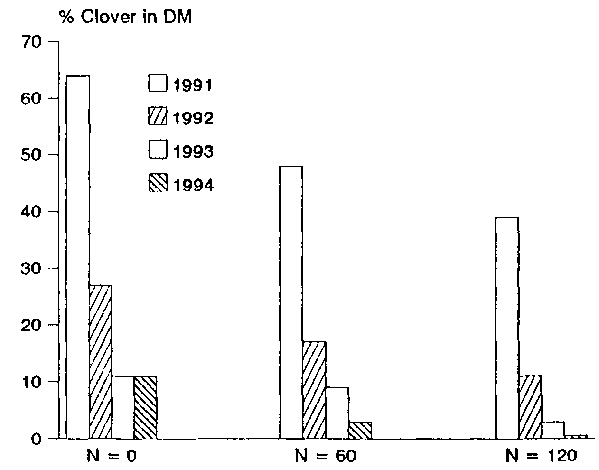P. Stypinski and P.K. Bukowiecki*
The Agricultural University of Warsaw, Rakowiecka 26/30, Warsaw, Poland
*The Institute of Land Reclamation and Grassland Science, Falenty, Poland
Introduction
Materials and methods
Results
Discussion
Conclusions
References
One of the main disadvantages of white clover is its year-to-year variation in sward content (Frame and Newbould, 1986; Lex and Simon, 1991). The persistence of white clover can also be a problem and increasing the persistence of white clover is one of the main goals of breeding work in Poland (Stypinski, 1991). White clover is of particularly low persistence under nitrogen fertilization, but variability could also be influenced by species and cultivars of companion grasses and by interaction with the type and cultivar of white clover in grass/clover mixtures. The objective of this experiment was to estimate the persistence of five Polish white clover cultivars in mixture with grasses and under three levels of nitrogen fertilization.
The experiment was carried out in 1991-1994 on black loam soil at the Falenty experimental station, near Warsaw. Five different Polish varieties of white clover (Astra, Armena, Alda, Anda and Rema) were sown in mixtures with the same companion grasses. In each mixture, clover content was 30%, with 70% grasses in the following proportion: Dactylis glomerata - 5%, Festuca pratensis - 20%, Lolium perenne - 15%, Phleum pratense - 15%, Festuca rubra - 10% and Poa pratense - 5%. Three levels of nitrogen fertilizer were applied in each year: N = 0 (without nitrogen), N = 60 (60 kg N ha-1 yr-1) and N = 120 (120 kg N ha-1 yr-1). The potassium (K) and phosphorous (P) fertilization was the same for all treatments (50 kg P and 120 Kg K ha-1 yr-1). Simulated grazing (four cuts yr1) was applied and the yields of dry matter (DM), chemical composition and the content of white clover in swards were measured systematically.
It is well known that nitrogen causes low persistence of white clover, but the another important factor could be the clover variety. According to breeders, the new varieties should be more persistent compared to older ones, but in practice this is not always the case. The results of this study confirmed that nitrogen fertilization reduces the sward content of white clover, regardless of the cultivar used in mixture with grasses. All of the cultivars tested had similar and rather low persistence. In the third and fourth years after sowing the percentage of clover in the swards as a mean of all cultivars was only 3 - 5% of DM. Nitrogen fertilization modified persistence of white clover and clover as a percentage of total DM was greatest in the N ^ 0 treatment; was reduced in the N = 60 swards and lowest in the N = 120 treatment (Figure 1). Differences between cultivars were not significant and from the second year after establishment, the percentage of white clover in the swards decreased rapidly. A summary of the influence of nitrogen fertilizer on white clover in presented in Figure 2. This also suggests that white clover decreased in sward content in the N = 0 treatment.
Figure 1. Mean percentage of white clover in the dry matter of mixed clover/grass swards from 1991 to 1994 for five clover cultivars at 0 kg nitrogen (N) ha-1 yr-1.

Figure 1. Mean percentage of white clover in the dry matter of mixed clover/grass swards from 1991 to 1994 for five clover cultivars at 60 kg nitrogen (N) ha-1 yr-1.

Figure 1. Mean percentage of white clover in the dry matter of mixed clover/grass swards from 1991 to 1994 for five clover cultivars at 120 kg nitrogen (N) ha-1 yr-1.

Figure 2. Mean percentage of white clover in the dry matter of mixed clover/grass swards from 1991 to 1994 averaged for all cultivars at 0. 60 and 120 kg nitrogen (N) ha-1 yr-1.

The basic question of why white clover is not persistent under Polish conditions remains unanswered. The results of this experiment confirm the results of Stypinski (1991) and Gawecki (1988). Clover content decreases rapidly after establishment and in the third year is very low; usually below 5% of the DM. The persistence of white clover can be improved by proper nitrogen fertilization strategies and by choosing appropriate companion grasses (Frame and Newbould, 1986), but generally it is very difficult to maintain the content of white clover in swards at an average of 20 - 30%, that is recommended as a level at which advantages are gained in the nutritional value of pasture herbage. A possible explanation of the lack of persistence could be the decomposition of clover root systems after one or two years post-establishment and the nitrogen thus released utilised by the companion grasses (Stypinski, 1993). Good clover establishment leads to high levels of nitrogen fixation and consequently in following years could result in strong competition from grass species. In addition, Rhodes (1991) reported that under grazing the key to persistence is the maintenance of an adequate base of stolons. Unfortunately, Polish breeders have not included such features in their development of new varieties of white clover.
1. Persistence of white clover is still not good in Poland and the second or third year after establishment the percentage of clover decreases rapidly.
2. Nitrogen is an important factor in white clover persistence and higher doses cause the acceleration of clover decline, but without nitrogen the phenomenon is still evident.
3. The differences between varieties in terms of persistence are not significant and thus, in this aspect, the new varieties are no better than old ones.
FRAME J and NEWBOULD P (1986) Agronomy of white clover. Advances in Agronomy, 40, 1-88.
GAWECKI J (1988) Wplyw odmian koniczyny bialej na plonowanie i wartosc pokarmowa ich mieszanek z trawami. Zesz. Pr. Post. nauk Roln., 366, 177 - 183.
LEX J and SIMON U (1991) Effect of grass variety, white clover type and management on the proportion of white clover and on dry matter yield in grass/white clover mixtures. Reur Technical Series, 19, 165 - 170.
RHODES J (1991) Progress in white clover breeding. Reur Technical Series, 19, 1 - 9.
STYPINSKI P (1991) The white clover works in Poland. Reur Technical Series, 19, 79 -92.
STYPINSKI P (1993) Reakcja koniczyny bialej (Trifolium repens L.) na Wapnowanie w siewach czystych i w mieszankach z trawami w doswiadczeniach pastwiskowych i wazonowych. Rozprawy Naukowe i Monograpie, 170, SGGW.